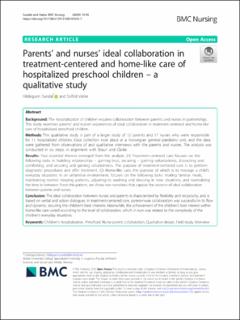| dc.description.abstract | Background: The hospitalization of children requires collaboration between parents and nurses in partnerships. This study examines parents’ and nurses’ experiences of ideal collaboration in treatment-centered and home-like care of hospitalized preschool children. Methods: This qualitative study is part of a larger study of 12 parents and 17 nurses who were responsible for 11 hospitalized children. Data collection took place at a Norwegian general paediatric unit, and the data were gathered from observations of and qualitative interviews with the parents and nurses. The analysis was conducted in six steps, in alignment with Braun and Clarke. Results: Two essential themes emerged from the analysis. (1) Treatment-centered care focuses on the following tasks in building relationships – gaining trust, securing – gaining voluntariness, distracting and comforting, and securing and gaining voluntariness. The purpose of treatment-centered care is to perform diagnostic procedures and offer treatment. (2) Home-like care, the purpose of which is to manage a child’s everyday situations in an unfamiliar environment, focuses on the following tasks: making familiar meals, maintaining normal sleeping patterns, adjusting to washing and dressing in new situations, and normalizing the time in between. From this pattern, we chose two narratives that capture the essence of ideal collaboration between parents and nurses. Conclusion: The ideal collaboration between nurses and parents is characterized by flexibility and reciprocity, and is based on verbal and action dialogues. In treatment-centered care, parent-nurse collaboration was successful in its flow and dynamic, securing the children’s best interests. Meanwhile, the achievement of the children’s best interest within home-like care varied according to the level of collaboration, which in turn was related to the complexity of the children’s everyday situations. Keywords: children’s hospitalization, preschool, nurse-parent collaboration, qualitative design, field study, interview | en_US |

